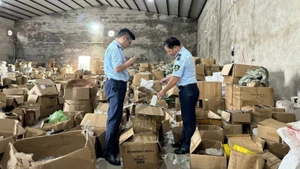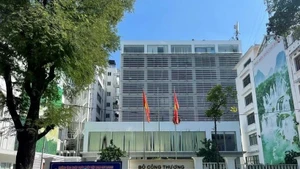At present, the Ministry of Industry and Trade is set to submit a scheme for increasing power prices, which have been kept unchanged since 2019, but that has put state utility Electricity of Vietnam (EVN) into huge financial losses.
The new scheme, if receiving a thumbs-up from the prime minister, will help EVN ensure its effective performance and shun continued losses.
It is widely reported that last year, EVN was hit by a loss of more than 26.2 trillion VND (1.14 billion USD), due to a high rise in input material prices, which are now still on the uptrend induced by geopolitical tensions.
EVN’s electricity production costs reached 419 trillion VND (178.21 billion USD) in 2019, and 493.3 trillion VND (21.45 billion USD) last year.
It is estimated that if the existing power price applied since 2019 continues to be kept, EVN will suffer from a financial loss of over 64.94 trillion VND (2.82 billion USD) this year, including about 44 trillion VND (1.91 billion USD) in the first half of 2023.
In February, EVN churned out a total of 20.2 billion kWh, up 9.4% year-on-year. However, in the first two months, the volume hit 38.61 billion, down 2.2% year-on-year.
Nguyen Xuan Nam, deputy general director of EVN, said that if a power price hike fails to become true, the loss would swell the group’s financial burden.
“The loss reported last year was ascribed to high input costs. The prices of coal soared three-fold, or even five-fold, while the double prices of natural gas and oil also contributed to the spike in input costs,” said Nam.
According to experts, if there is a rise in electricity prices, prices of many other items in the market will also be increased, as electricity is vital to all economic sectors in the economy. This will also cause pressure on the government’s efforts to bring inflation under control.
What is more, in the domestic market, another driver of inflation is looming, which is an increase in fuel.
Early this week, Brent crude futures increased by 44 US cents, or 0.6%, to 86.2 USD a barrel, against a few days earlier. WTI crude futures were trading at 81.1 USD a barrel, up 46 US cents, or 0.63%.
Both benchmarks escalated over 6% after OPEC+ rocked markets with an announcement of production cuts of 1.66 million barrels per day (bpd), from May until the end of 2023.
This will bring the total volume of cuts by OPEC+ to 3.66 million bpd, including a two million barrel cut last October, tantamount to about 3.7% of global demand.
Because the Vietnamese fuel market largely relies on the global market, its prices will see a high level. Though there has been a slight reduction in fuel prices - petrol prices may drop by 320-450 VND (1.4 – 1.9 US cents) per litre, and 100-400 VND (0.43-1.7 US cents) per litre of oil, the fuel prices in the market are generally staying at a high level. It is expected that these prices will continue rising in the coming months, as there is no signal of reduction in the global oil market.
From the beginning of this year, the petrol prices have undergone 10 adjustments, with six times up, three times down, and once unchanged.
According to Swiss-based multinational energy and commodity trading company Vitol Group, oil prices could reach a 90-100 USD per barrel range, in the second half of this year and even in the whole year, as global demand is set to reach record levels amid constrained supply.
One of the key drivers of a high hike in oil prices this year is China’s economic recovery. According to the World Bank, nearly half of the growth in oil consumption in 2023 is expected to come from China. The Bank of America argued that as the Chinese country reopens, more than a billion people will start travelling and spending, raising demand for energy and other commodities. Goldman Sachs has also estimated that China’s reopening will add one million barrels per day to global demand (or about 1% of world consumption), putting an extra 5 USD a barrel to oil prices.
All these oil-related factors will push inflation up, including that in Vietnam this year, when the country wants to rein in the rate at 4.5%.
Meanwhile, the World Bank expected Vietnam’s inflation is estimated to average about 4.5% in 2023, the same as expected by the Vietnamese government.
“This estimation assumes that inflation in the first half of the year will be affected by the still-dissipating effects of the March 2022 fuel price shock and the withdrawal of the 2% VAT tax break, provided as part of the economic support package in 2021,” the bank said. “In the second half of 2023, higher electricity prices and a salary increase for civil service workers will affect inflation. The consumer price index is expected to moderate to 3.5% in 2024 and 3% in 2025, returning to pre-pandemic levels.”
Giving their view on the inflation outlook of Vietnam, analysts at the Economist Intelligence Unit commented, “Consumer price inflation will begin to ease in the second quarter of 2023, from a peak of about 5% in core inflation in the first three months of the year. A more rapid deceleration will take hold in the second half of 2023, as declining global energy prices translate into easing cost-push pressures across a range of goods and services, while a higher base of comparison from the year-earlier period will also come into play.”
The Asian Development Bank (ADB) has also commented, “Services are expected to expand by 8% in 2023, on revived tourism and associated services. China initially left Vietnam off the list of countries that could receive its outbound tourists. On March 12, 2023, though, a revised list added Vietnam, allowing group tours from China to Vietnam to resume on March 15. As China is Vietnam’s largest tourist market, the country will benefit considerably from this development.”
Public investment will be the key driver for economic recovery and growth in 2023. A considerable amount of public investment is scheduled to be disbursed in 2023. The government is committed to disbursing 30 billion USD in the year, of which 90% had
been allocated to disbursing ministries and provinces, as of January 2023.
“On the demand side, domestic consumption will continue to rebound in 2023. Revived tourism, new public investment and stimulus programmes initiated in January 2022, and a salary increase effective in July 2023, are expected to keep domestic consumption on the rise, though higher inflation may hamper its recovery,” the ADB said.
The ADB suggested that Vietnam should continue to prioritise price stability because escalating geopolitical tensions and accelerating disbursement of public investment may still stoke inflation in 2023.
“Inflation is to increase slightly to 4.5% in 2023,” the ADB said.
FocusEconomics Consensus Forecast panellists meanwhile expect Vietnam’s inflation to average 3.9% in 2023, and 3.4% in 2024.
According to Vietnam’s General Statistics Office, the consumer price index in March 2023 decreased by 0.23% against that of February 2023, up by 0.74% as compared to that of December 2022 and up by 3.35% in comparison with that of the same period last year.
















